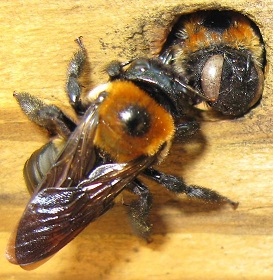Habitat
Xylocopa virginica
is found in Eastern, Central, and Southern United States as well as
Southern regions of Canada (Barrows 1983). More specifically, they
can be found anywhere from Texas to Florida and also from southern
Ontario to Maine, as shown in the map (Richards 2011).

The nests that these bees create are very important aspect of
their reproductive and survival success. Females take on the role of
making the nest and will often inhabit this nest over their
lifetime. However, if they choose to not return to that nest, they
will often construct a new nest in a similar location (Gerling and
Hermann 1978). Having a familiar nest allows for recognition and
avoidance of aggression towards nestmates. Being able to distinguish
between nestmates and non-nestmates enables X. virginica to
use their
energy productively to benefit the nest (Peso and Richards 2010). To
delve into more detail, visit the
Interactions page.
The Eastern Carpenter Bee requires a fairly specific niche.
This bee prefers to live in soft wood and more specifically has been
found to live in dead trees, logs, wooden benches, and picnic tables
(Barrows 1983). While they do choose wood as a habitat, these
organisms will not nest in wood that has been painted or otherwise
altered
 by humans (BugGuide 2013). This habitat preference resembles
that of Xylocopa varipuncta, the Valley Carpenter Bee. To
learn more about this organism click
here.
by humans (BugGuide 2013). This habitat preference resembles
that of Xylocopa varipuncta, the Valley Carpenter Bee. To
learn more about this organism click
here.
These bees make distinctive circular holes that serve as the
entrance of their nest. X. virginica burrow through the
wood, creating tunnels approximately 44.45 cm in length. Their
tunnels often run with the grain of the wood creating parallel nests
that do not intersect with another female's nest (Gerling and
Hermann 1978). As they create the tunnel, they do not ingest the
wood they are gnawing through. Instead, they use the chewed wood to
support their nest (Encyclopedia of Life 2013).
The nest serves multiple functions for the Eastern Carpenter
Bee. One of the functions includes laying their eggs in the nest.
After the eggs are laid, the female places nectar to nourish the
developing offspring. She then uses the chewed wood to create a wall
which separates the eggs and the nectar from the rest of the nest
(North Carolina Museum of Natural Sciences 2013).The nest provides shelter for the offspring
after hatching. They remain in the nest for two to three weeks (Gerling and Hermann 1978). The nest
not only provides shelter for the offspring, but also for the
overwintering adult X. virginica. During the warmer
months, both male and female Eastern Carpenter Bees spend a large
amount of time out of nest foraging for food to prepare for the
winter (Prager and Richardson 2012).
Continue to
Form and Function
Return to
Home
Go to
References